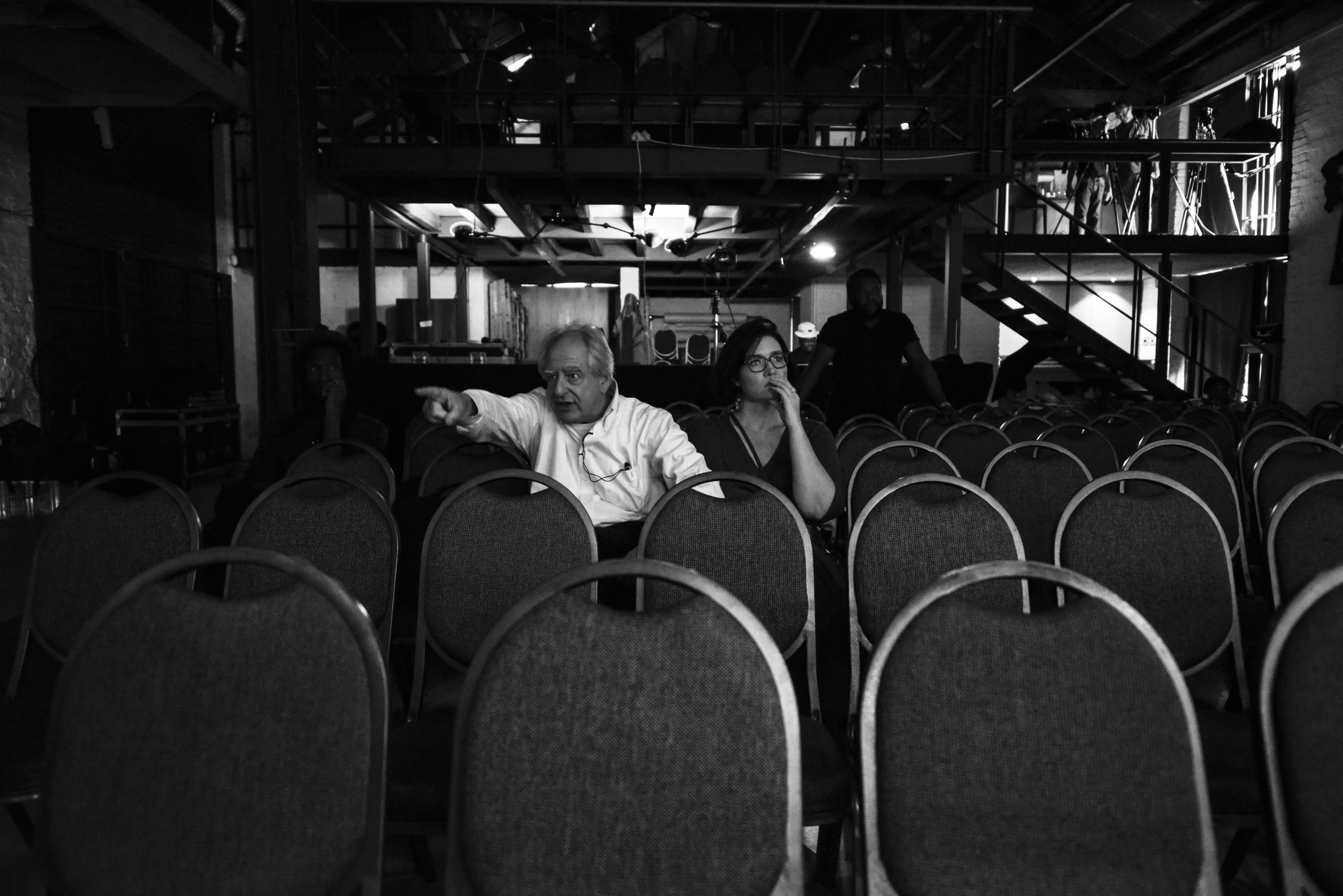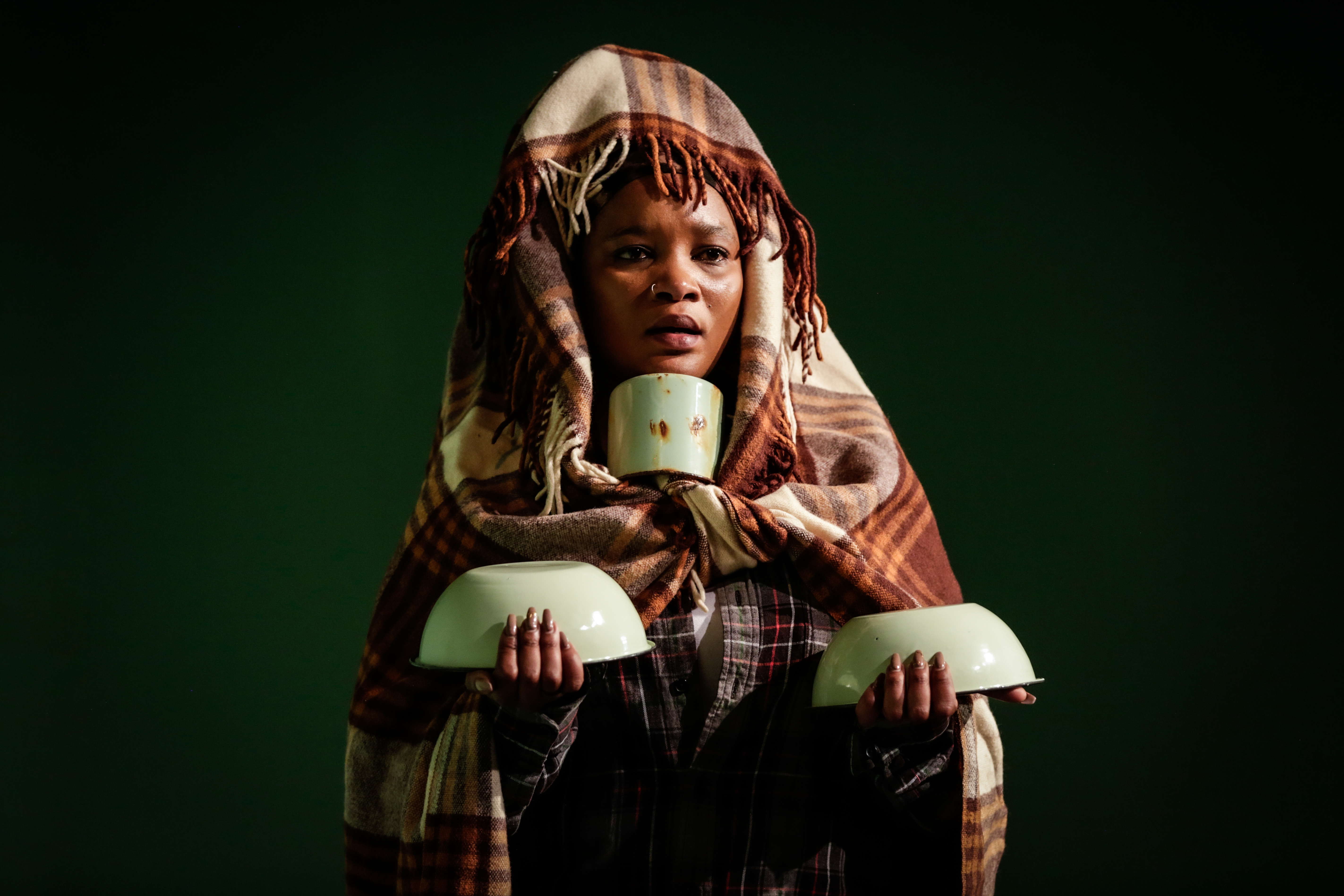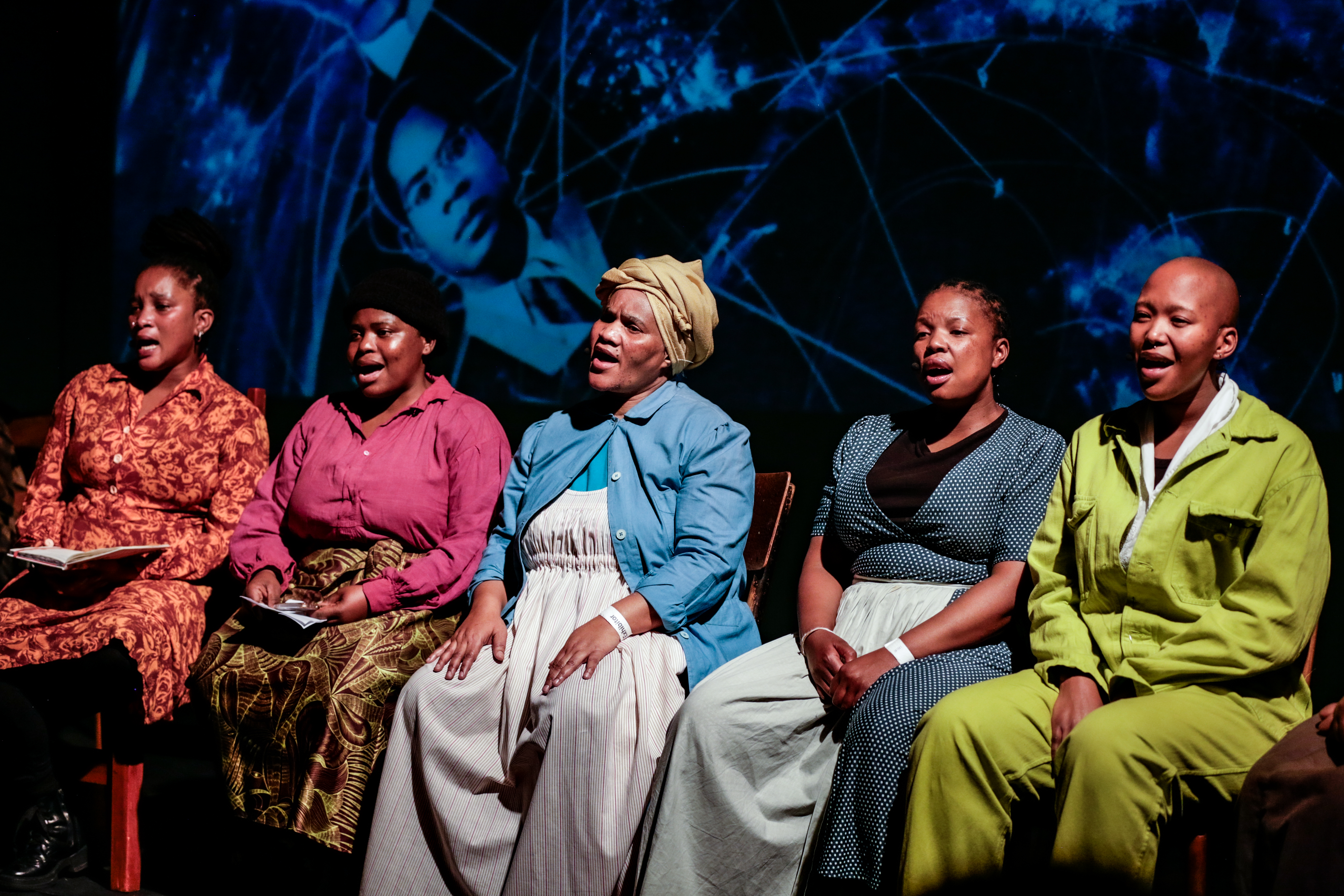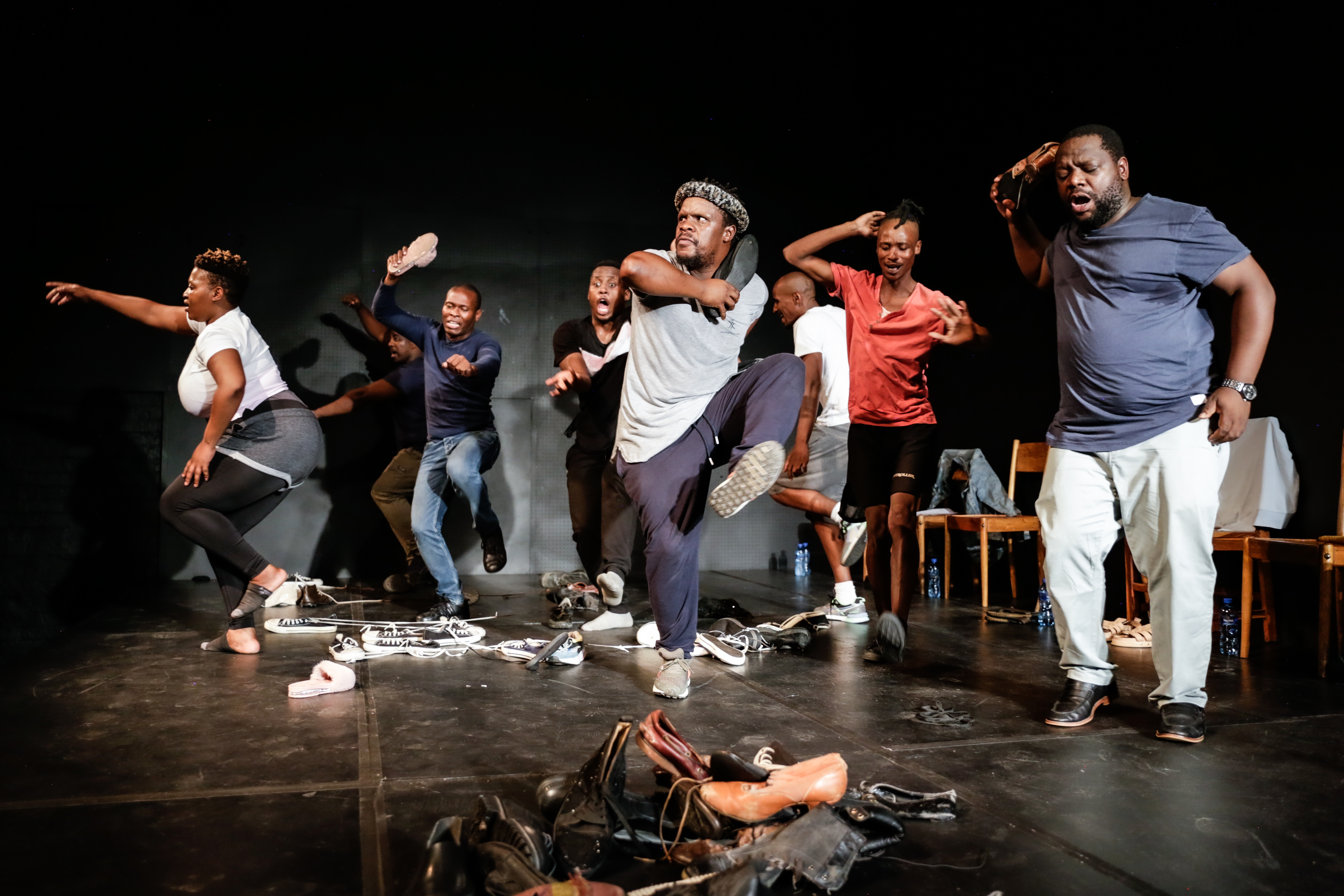Reflecting on seven years of the less good idea
- by David Mann
“Often, you start with a good idea. It seems crystal clear at first, but when you take it off the proverbial drawing board, cracks and fissures emerge, and they cannot be ignored. It is the process of following the secondary ideas, those ‘less good ideas’ coined to address the first idea’s cracks, that The Centre nurtures, arguing that in the act of playing with an idea, you can recognise those things you didn’t know in advance but knew somewhere inside of you.” – William Kentridge
---------

William Kentridge and Bronwyn Lace at the Centre for the Less Good Idea, photography credit: Stella Olivier
Arts on Main is alive with small pockets of activity. A choir disrupts a performance lecture upstairs, while a short-form theatrical epic is being shaped on The Centre’s main stage. Elsewhere, a pianist and a team of percussionists play around with new compositions, while an artist performs a duet with their own reflection.
It’s mid-August 2023, and in Johannesburg’s Maboneng, artists, writers, dancers, choreographers and musicians have come together to develop new work for a five-day festival of experimental and interdisciplinary art and performance at The Centre for the Less Good Idea.

Scene from '11-Minute Epics' at the Centre for the Less Good Idea, photography credit: Zivanai Matangi
Born out of an initial workshop session in April, these performances-in-process will ultimately form part of a series of curated programmes and individual works. For now, the ideas are still loose, tentative, and being discovered on the workshop floor.
Here, process is paramount, and the developing idea is given the benefit of the doubt. It’s a creative methodology that’s been central to The Centre’s ways of working since its inception.
From 18 to 22 October, The Centre for the Less Good Idea celebrates seven years of collaborative, experimental and interdisciplinary work with the staging of its 10th Season. The Season, which brings together a choir, processional bands, and over 60 individual directors, performers and musicians, will be both a reflection on, and a celebration of, the journey that The Centre has taken since its inception.
A history of pursuing the less good idea
Back in 2016, the South African artists William Kentridge and Bronwyn Lace came together to found a space committed to creating and supporting experimental, collaborative and cross-disciplinary arts projects.
“During our first few months of co-thinking William shared with me a Tswana proverb he had used in one of his Blue Rubrics,” explains Lace.
E a re ngaka kgolo go retelelwa, go alafe ngakana / If the good doctor can’t cure you, find the less good doctor.
So emerged The Centre for “the Less Good Idea”. This grammatically unwieldy and amusing phrase began to define the kinds of secondary artistic processes that took shape at The Centre. Over the years, pursuing the less good idea has become The Centre’s primary methodological and philosophical approach – the process of locating that which is secondary: the peripheral idea, the incidental discovery, and the flickering light at the edges.
Reflecting on the first ideation workshop in 2016, Lace describes being in the midst of a magnificent storm of contemporary art production.
“It was the third day of an intense and massively generative five-day incubator workshop toward the inaugural Season for The Centre for the Less Good Idea,” says Lace. “Around 80 artists from every discipline were involved in the pursuit of new combinations of texts, movements, sounds and images. As incidental discoveries arose, they were identified, pursued, and captured on film, in sound and written about, the fluidity of the process was being held and reflected back to ourselves and the artists on an hourly and daily basis. The space was intuitively giving all its attention and resources to the impulses, connections and revelations identified by the artists.”

Scene from the 'Great Yes, the Great No' at the Centre for the Less Good Idea, photography credit: Stella Olivier
Today, these ideation workshops, and the reflexive, intuitive, and collaborative frameworks they operate within, continue to be the primary generators of original material towards new Seasons of work. Under the guidance of a number of different curators, each Season has produced original, innovative work, much of which has gone on to grow and take on new forms outside of The Centre, frequently touring outside of South Africa.
An opportunity to revisit and reflect
The act of translation, the inherent performance of the city, the collapsed conference and the short-form epic are some of the ideas that have animated previous Seasons at The Centre. These ideas have been held and developed by key curators ranging from the fields of performance and visual art, to architecture and poetry.
Season 10 stands apart from previous Seasons in that it has no curators and no central theme or provocation. Rather, the shape of the Season is defined by a process of reflecting upon and revisiting those programmes, performances, and approaches that have come to define The Centre’s key processes, methodologies, and ways of working over the years.
Speaking to the history of The Centre, and its journey towards this 10th Season, Kentridge explains that the growth of the organisation has been guided by its community of artists, directors, writers and performers.
“More than 800 artists of different forms have worked at The Centre over the years, which makes for a community of collaborators that The Centre works with in ways that are wonderful, rich and surprising. That feels like a very strong and organic kind of expansion,” says Kentridge.
The artists invited into Season 10 are those who have influenced The Centre deeply, but who have also been influenced by The Centre, co-developing the particular methodologies and strategies, and performance programmes that have become seminal to The Centre’s growth as an organisation.
 Scene from 'Evening of Percussion' at the Centre for the Less Good Idea, photography credit: Zivanai Matangi
Scene from 'Evening of Percussion' at the Centre for the Less Good Idea, photography credit: Zivanai Matangi
These include two newly devised programmes of 11-minute Epics – a performance format that holds all of the activity, emotion, humour, triumph, and tragedy of the theatrical epic in the short form – and the two-part public procession No Man’s Land led by Sello Pesa, which takes performance out of The Centre and into the public spaces of the city. A revisiting of the Collapsed Concerts – musical performances that centre the logic and process of live collaboration, improvisation – are also central to the Season.
Opening the Season is a new version of Kentridge’s A Defence of the Less Good Idea. A performance lecture that is deliberately drowned out and collapsed through the performance of other artists, it’s the performance that opened The Centre’s inaugural Season in March 2017.
Newly incubated works planned for Season 10 include an evening of percussion composed and conducted by South African percussionist Tlale Makhene and Benin-born percussionist Angelo Moustapha, and two new programmes of Pepper’s Ghost performances focussing on Activating the Archive, curated by Bongile Gorata Lecoge-Zulu and Bronwyn Lace.
Theatremakers Phala Ookeditse Phala and Tony Miyambo will be debuting Eribuweni Ra Lwande | On the Shoreline, a new solo work born out of a recurring dream full of fragments, and composers and performers Sbusiso Shozi and Nhlanhla Mahlangu will revisit their internationally renowned African Exodus, which began its journey at The Centre back in 2018.
Further original works include new short-form theatre by Gregory Maqoma, while Magnet Theatre’s Mark Fleishman and Jennie Reznek will work alongside Neo Muyanga and Marcus Neustetter in a new take on Antigone’s Ode to Man.
The Great Yes, the Great No – a new theatre project by William Kentridge
Central to Season 10 is a showing of the first iteration of William Kentridge’s latest theatre work, The Great Yes, the Great No which centres around a historical escape from Vichy France by, among others, the surrealist André Breton, the anthropologist Claude Lévi-Strauss, the Cuban artist Wifredo Lam, the communist novelist Victor Serge, and the author Anna Seghers.
As with many of Kentridge’s recent, large-scale theatre and opera works, including The Head & The Load and Sibyl, The Centre has been significantly involved in The Great Yes, The Great No.
“As an organisation, we’ve grown many of our strategies and approaches out of the ways in which William naturally works collaboratively with large groupings of people from diverse disciplines,” says Lace. “Similarly, the artists that William has met through The Centre – performers, choreographers and composers – have come to be vital parts of his work and his productions.”
 Scene from the 'Great Yes, the Great No' at the Centre for the Less Good Idea, photography credit: Stella Olivier
Scene from the 'Great Yes, the Great No' at the Centre for the Less Good Idea, photography credit: Stella Olivier
Moments of Making
In line with reflecting on the growing archive of process-based performance at The Centre, the multimedia exhibition and installation, Moments of Making, will also run throughout the Season.
Reflecting on the playful, intangible, and often-times-vulnerable moments that emerge during the pursuit of the less good idea, the exhibition features a short process-based film, photography, text, and a sound installation, and is curated by The Centre's Director of Cinematography & Editor, Noah Cohen.
“The film itself is made in the spirit of the less good idea so it’s fragmented, collaged, collaborative, and playful,” explains Cohen. “The hope is that it helps audiences realise and experience what the creative process can look and feel like.”
 Scene from 'African Exodus' at the Centre for the Less Good Idea, photography credit: Zivanai Matangi
Scene from 'African Exodus' at the Centre for the Less Good Idea, photography credit: Zivanai Matangi
As ideas continue to find their shape on the workshop floor, and artists discover new ways of developing and presenting their work, another Season of experimental, interdisciplinary and collaborative work presents itself to audiences of The Centre for the Less Good Idea.
– David Mann is a Johannesburg-based writer and editor who writes at the intersections of art, architecture, performance and fiction. He has worked as the writer for The Centre for the Less Good Idea since 2018.
References
"E a re ngaka kgolo go retelelwa, go alafe ngakana / If the good doctor can’t cure you, find the less good doctor" - from a book titled Sechuana Proverbs with Literal Translations and Their European Equivalents by Solomon Tshekisho Plaatje (October 9, 1876–June 19, 1932)
Further Reading In Articles
African Artist Directory















